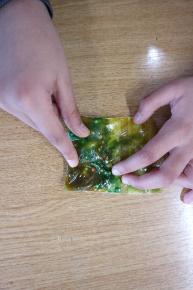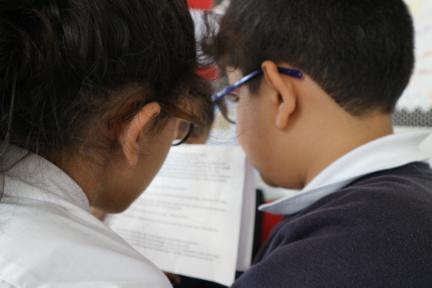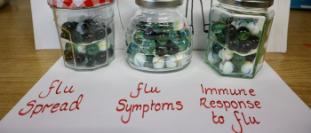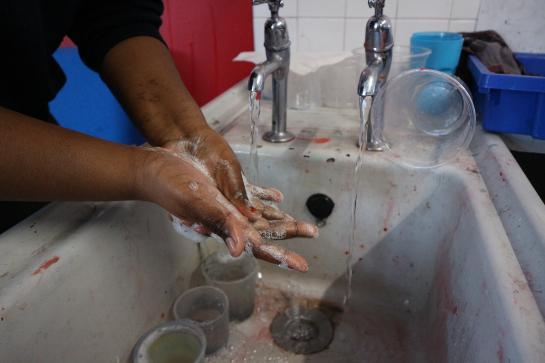2020 Activities
2020: What are viruses and how do they make us ill?
2020 was the first year of the project focussed on describing what viruses are and what happens when we get infected. The classroom activities we designed turned out to be very apt as we delivered this the week before the UK entered lockdown because of the COVID19 pandemic!
The engagement ran for three days across one week. Each day we started with some new information presented in some engaging slides which included an opportunity for the pupils to ask questions. You can find the slides we used here 2020 PowerPoint Slides
We then ran the following activities designed to increase the pupils knowledge of how flu spreads; the immune response against it; and how viruses can change when they pass between different people. We also hoped that the pupils would learn some simple processes to reduce virus spread including washing their hands and coughing or sneezing into a hankie.
We aimed for the pupils to design their own activities to help younger children understand more about viruses but we were not able to complete this part of the project due to COVID19 restrictions.
We’ve made a Glossary of terms to help with the activities at the bottom of the page, or download Glossary Year 1
+++
Activity 1: Passing germs
In this activity, we aimed for the pupils to learn that germs can be transferred between people via direct contact or objects. Pupils’ hands or a plastic ball were sprayed with a UV visible dye and we tracked the transfer of the dye between pupils and tested whether the pupils could wash their hands well-enough to get rid of the bugs!
You can find the How To for this activity Washing hand activity
Improvements/things to be aware of
For a more formal assessment of handwashing, we could have timed how long each pupil took to wash their hands and then ask whether they had removed all the dye. This proved impractical on the day as the pupils were excited to wash their hands.
---
+++
Activity 2: Snot – what is it good for?

In this activity, we wanted the pupils to learn that the snot that comes from your nose when you have a cold or the flu is part of your immune response against the virus. Pupils made snot and used to it to capture bugs!
You can find the How To for this activity Snot What is it good for Activity
Improvements/things to be aware of
We could have improved this activity by using less single use plastic, for example by giving each pupil a small saucer to make their snot on.
---
+++
Activity 3: Flu whispers
In this activity, we wanted the pupils to understand that viruses can change when they pass between different people. We adapted the ‘Telegraph’ game in which each pupil whispers a message into the ear of the person next to them and asked how much the message changed after being ‘transmitted’ between pupils.

You can find the How To for this activity Flu whispers activity
Improvements/things to be aware of
We could have improved this activity by writing down the message at the end of the activity and showing the pupils how much it had changed.
---
+++
Virus wanted poster
After each activity, we asked the pupils to add information to a ‘virus wanted’ poster. This included a drawing of their virus and information on the symptoms it causes, how it spreads, and how it can be prevented.
You can download a version of the poster to use in your own activities - Blank virus wanted poster
Or you can look through some terrifying viruses that the pupils drew - Children's completed virus wanted poster
---
+++
Evaluation

The aim of our evaluation was to find out if the pupils enjoyed the activities, telling us whether we were connecting science with an enjoyable experience for them. We also wanted to learn from their completion of the worksheets if the pupils had learnt some of the key points about viruses and the immune system we covered in the slides and activities.
The engagement was a success – the pupils reported that they had enjoyed the activities and learnt from them. Their ability to use their knowledge to complete the worksheet demonstrated their learning. Their engagement was observed through their willingness to answer and ask questions and that they enjoyed the activities – e.g. keen to show off the snot they produced to us and each other, laughter during the Passing Germs and Flu Whispers activities, and that we had to ask them to stop the activity to move onto the next part of the programme.
You can read about the details of our evaluation process here
Improvements
We could have gained more information from our evaluation if we had used a method that allowed us to track the before and after responses of each pupil to measure their gain in knowledge. We used this approach in some of our evaluation in Year 2 of the project. We also could have counted the number of pupils who were willing to answer or ask questions, for example by counting the number of hands that were raised. We weren’t able to take this approach in Year 2 as this was delivered online!
---
+++
Glossary
- Antibodies: These are made by an immune cell called a B cell and can latch onto and neutralise viruses allowing the body to remove the virus safely.
- Immune cells: these are cells that protect the body from infections. There are lots of different types of immune cell that work together to protect the body.
- Lung cells: these cells make up the lung giving it structure so it can function properly.
- Macrophages: these are one type of immune cell that can engulf the virus and destroy it.
- Microscope: This is a piece of equipment that makes small objects e.g., viruses appear enlarged on an image revealing details too small to be seen with the naked eye.
- Respiratory system: this is the part of the body that ensures you can breathe in the oxygen you need and breath out carbon dioxide. It includes the nose, throat, and lungs.
- Snot: this is made by immune cells in the upper respiratory system (nose/mouth) and helps to capture bugs so that the body can expel them.
- Symptoms of disease: This is a physical problem that you feel when you are unwell
- Virus: these are bugs that infect cells and make lots of copies of themselves. They cause damage to cells and make the body feel unwell.
- Virus mutation: This happens when viruses make more copies of themselves. The virus can change its coat proteins escaping the antibodies the person has made to protect themselves. The virus can now infect the person again and cause disease.
- Virus transmission: this describes how viruses can move between different people – for example by an infected person coughing or sneezing on someone else.
---


